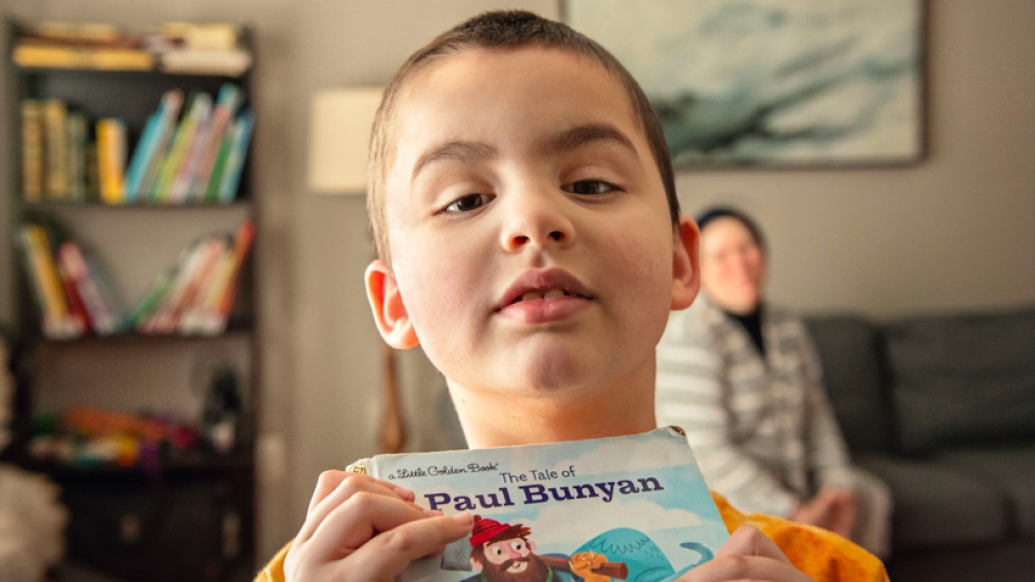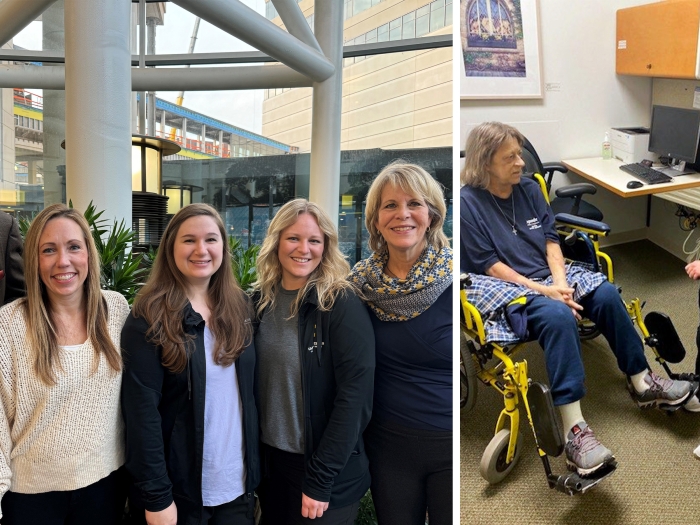Thousands of children face seizures, developmental delays, and possible death from Dravet Syndrome. A new treatment built on Michigan Medicine research could help.
5:07 AM
Author |

Zain Tello grips a flyswatter, his big, brown eyes widening as he pretends it's a double-bladed ax, just like Paul Bunyan's.
He loves tall tales, like Bunyan and John Henry, says his mother, Susie Luebke. It makes sense, given the 8-year-old's life. The stories are full of characters tackling enormous obstacles.
Tello, who is from Ann Arbor, began having seizures when he was 5 months old, including some so severe he had to be intubated in the ICU. At age 3, he was diagnosed with Dravet Syndrome, a rare, genetic epilepsy. In addition to seizures, it can cause cognitive and developmental delays and carries a high risk of sudden unexpected death in epilepsy, or SUDEP.
When Tello was diagnosed, treatment options for Dravet were limited. Now, he's the first patient in Michigan to enroll in a clinical trial for a new investigational medicine.
How he got there is an epic tale of collaboration, innovation, and care that follows a path from basic research in Michigan Medicine laboratories to the treatment that could change Tello's life — and the lives of thousands of other patients with Dravet Syndrome.
"I look at Zain almost as a little pioneer man to lead this way forward for us," said Sucheta Joshi, M.D., professor of pediatrics, Tello's pediatric neurologist, and the medical director of pediatric epilepsy at C.S. Mott Children's Hospital.
Building a foundation of basic science
Lori Isom, Ph.D. — the Maurice H. Seevers Collegiate Professor of Pharmacology and chair of the department — has always been thrilled by basic science.
Her 30 years of research have focused on studying sodium ion channels: gateways in the membranes of neurons, cardiac myocytes, and other cells. The correct flow of sodium ions through these channels is the basis of electrical signaling in the body.
Isom's colleague, Miriam Meisler, Ph.D., the Myron Levine Distinguished University Professor of Human Genetics, was among the first scientists to show that sodium ion channels are associated with Dravet Syndrome. Isom and her team study mice with faulty sodium channels to mimic the disease, providing a model for research.
Human genome mapping later showed about 80% of Dravet patients have variants in the gene SCN1A — which tells the body how to build an important sodium channel in the brain.
People with variants that cause Dravet have one typical copy of SCN1A and one that doesn't function correctly. As a result, the body doesn't make enough healthy versions of the channel, leading to epilepsy.
Connecting the brain and the heart
Isom and her team were the first to figure out that SCN1A variants affected the flow of sodium in cells in the heart as well as in the brain.
"That's how basic science intersects with clinical medicine," Isom said. "If you are a sodium channel biologist, and you know the same genes are expressed in the heart that are expressed in the brain that make epilepsy happen, you think, 'Hey, could these things be linked?'"
Isom's lab examined three different mouse models of genetic epilepsy and found cardiac arrhythmia in all three.
Isom turned to a longtime colleague at Michigan Medicine to further understand the effects of the link. Jack Parent, M.D., is a physician-scientist, the William J. Herdman Professor of Neurology and co-director of the Comprehensive Epilepsy Center.
Parent and Isom have collaborated since 2008, drawn together by a shared interest in research to stop SUDEP and supported in part by families that have been impacted by a SUDEP tragedy.
As a clinician, Parent sees patients with epilepsy at Michigan Medicine. Through their work with the Dravet Syndrome Foundation scientific advisory board and the American Epilepsy Society, he and Isom have met Dravet patients and their families from all over the United States. They've seen family members' fears as they raise children with this difficult to treat, and often deadly, disease.
"What's really scary to families is Dravet has perhaps the highest incidence of SUDEP of any of the epilepsies. That's the most catastrophic consequence," Parent said. "They have that hanging over their heads. Even though the seizures tend to improve later in life, patients still have cognitive impairment and develop gait abnormalities and other problems, so it's really a lifelong disease."

Parent, alongside fellow lab researcher and pediatric neurologist Louis Dang, M.D., Ph.D. and other lab members, specialize in working with induced pluripotent stems cells. They can take skin or other cells from epilepsy patients and convert them into stem cells. They then transform them into brain or heart cells, creating research-ready cell lines with the same genetic variants as the patients.
Parent’s lab made heart cells from patients with three types of genetic epilepsy. Isom examined them, again identifying indicators of arrhythmia. In 2018, they looked at heart cells from a cohort of Dravet patients, leading to similar results – and allowing them to alert one child’s doctor to a heart abnormality before it was diagnosed.
Leaping from the lab to the clinic
Isom and Parent presented their work at an American Epilepsy Society meeting in 2018. A representative from a biotechnology company, Stoke Therapeutics, attended their talk and approached them with an idea for treating Dravet based on their foundational research into the effects of SCN1A variants.
Isom knew she could test the treatment with her mouse models, and Michigan Medicine's Fast Forward Medical Innovation program helped facilitate discussions with Stoke. The researchers were poised to do the work.
"The basic science is precious. It's foundational. We can't do anything else without basic science. But now we have to take that a step further," Isom said. "And that's what pharmacology is, right? Our goal is to use our basic knowledge to benefit public health."
When Isom's team began testing Stoke's investigational therapy, they were stunned.
"It was incredible," Isom said. "We went from seizures and SUDEP in 70% of the mice to almost none."
The treatment directly targets the cause of Dravet: the SCN1A gene. The medicine tells brain cells to amp up expression of the healthy copy of the gene. The cells then generate more of the protein that makes up the important sodium channel, which compensates for the faulty gene variant.
The researchers and their collaborators published a paper about the study in Science Translational Medicine in August 2020, showing that Stoke's treatment led to more healthy sodium channels in Isom's mice.
These results served as evidence for the U.S. Food and Drug Administration to allow clinical trials. Working with researchers around the country, Stoke launched the multi-center MONARCH Study to test their medication. Michigan Medicine is a site for this pivotal trial.
The first group of human subjects received treatment in August 2021. Tello received his first dose this spring.
Waiting for a cure
Zain Tello and his mom Susie enjoy a nature walk in late winter.
Dravet has shaped not only Tello's life, but also his entire family's.
"It doesn't just affect the child, it affects the whole family in ways you don't understand until you're in it, good and bad," Luebke said. "But it's a whole family experience. It's not just the child having seizures."
Tello is the youngest of six siblings. His big brothers and sisters, ages 13 to 25, have learned patience and understanding from growing up with him, Luebke says. They know, for example, they might not be able to go out on a hot day because it triggers his seizures. They know family camping trips have to be limited to routes close to children's hospitals. They also know their sweet, exuberant little brother adores them.
"He tells each of them, 'I love you the most,' and hugs them, and then you'll hear him go say it to someone else," Luebke said.
When Tello was diagnosed, it was in part a relief — at least they knew what was wrong. But it was hard to learn there wasn't a simple solution. Some medications that help children with other epilepsies aren't good for kids with Dravet. Other treatments might reduce seizures but cause serious side effects.
"You want something to work, but you never know what's going to happen," Luebke said. "The seizures could get worse, get better. At one point we were on maybe four different medications, trying to get them stable. You're just hopeful that something would work."
The seizures aren't Tello's only challenge. He's on the autism spectrum and has severe developmental and cognitive delays from Dravet. Finding a good fit for his education has been hard, Luebke says, especially during the pandemic. She's become an "accidental homeschooler" — Tello can't attend virtual school because screens trigger his seizures.
Tello has difficulty with communication and speech, but he's outgoing and friendly. He calls his siblings his best friends and loves visiting his doctors at Mott.
Luebke says they're blessed to have a doctor like Joshi, who has specialized knowledge from treating other children with Dravet. Luebke, like many parents of children with rare diseases, gathers all the information she can to advocate for her son.
"I feel here that our family's cares and concerns are taken seriously, and that we're more of a partner in our care," she said. "We feel supported."
Luebke is part of a Dravet Syndrome Foundation group for caregivers and knew about the MONARCH Study before it launched. She was eager to enroll her son, especially because the trial was available so close to home.
She'll take any opportunity for him to have fewer seizures, and she hopes to find a treatment that improves his other issues as well.
But her biggest dream for him is simple: "I hope that he's happy, and he has a good quality of life," she said. "I think that's it."
Expanding understanding of Dravet
Tello also participated in a multi-site control study designed to come before MONARCH: The BUTTERFLY Observational Study. The principal investigator for the Michigan Medicine site was Julie Ziobro, M.D., Ph.D., assistant professor of pediatrics and a pediatric epileptologist.
Zain greets a neighborhood dog while out for a walk.
Because all the children who participate in MONARCH will receive Stoke's medicine, rather than any group receiving a placebo, the BUTTERFLY Study serves as the baseline for the clinical trial. Researchers documented the neurocognitive abilities of Tello and other children with Dravet, examining the effects of the disease beyond seizures. They'll be able to compare these results with those from children who receive Stoke's treatment.
Ziobro was drawn to Michigan Medicine because of its supportive and collaborative atmosphere. "When I started my pediatric neurology training, I realized that there's this whole realm of genetic epilepsies that are difficult to treat," she said. "But we have all these new things on the forefront that I really wanted to be a part of."
Ziobro is now working on both ends of the research spectrum at Michigan Medicine: the clinic and the lab. In addition to treating Tello and other patients and leading the BUTTERFLY Study, she's been working with Isom and Parent on further research to understand how Dravet affects the heart.

Parent and Isom are working on multiple other projects to continue investigating SUDEP and ways to help patients with Dravet and other genetic epilepsies.
One, supported by a National Institutes of Health grant, aims to identify biomarkers that would predict SUDEP risk in children. The researchers are using patient-derived heart cell lines and mouse models to investigate two different genes associated with high vs. low SUDEP risk, respectively, comparing them to see whether the high SUDEP risk cells correlate with abnormal cardiac excitability.
"These kids are typically not evaluated by pediatric cardiologists, and we're going to figure out whether they really should be," Parent said. "That might change clinical practice."
Looking forward to organoid research and early detection
Parent is also expanding his stem cell work, using patient-derived cells to create organoids — 3-D clusters of cells. These are better models for drug discovery than typical 2-D cell lines, Isom says, because they mimic brain networks and architecture.
"It's the most fascinating thing I've ever seen," she said. "You can record from them, you can make brain slices from them, you can record neuronal activity."
The researchers anticipate that organoids grown from Dravet patients' cells will show different development than those from people without Dravet.
They are also using their mouse model to investigate whether the Stoke treatment might ease Dravet's behavioral effects as well as seizures — and trying to determine how early in life the medication should be given to have the greatest benefit.
One of Isom's biggest hopes for the future is that SCN1A will be included in newborn screening panels. Joshi says this would allow doctors to start treating children even before they showed symptoms.
"If we get to the point where we have a handful of epilepsies where we have these kinds of targeted treatments, diagnosing these kids very, very early would also be something I would love to see happen," Joshi said. "Those would be great things to look forward to in the future."
Collaborating exponentially for the future
The future is on the mind of every researcher and clinician who works with Dravet at Michigan Medicine. In the past few years, their collaborative work has unraveled mysteries and opened the door to immense possibilities.
Zain enjoys jumping and playing outside.
"There is no way either one of our labs could have done this by ourselves," Isom said. "And it's not just additive, it's synergistic. It's exponential."
In a few years more, they hope, the future will be even brighter for children like Tello.
"We're all anxiously awaiting to see how this drug trial plays out," Ziobro said. "Zain's story is still being written."

Explore a variety of health care news & stories by visiting the Health Lab home page for more articles.

Department of Communication at Michigan Medicine
Want top health & research news weekly? Sign up for Health Lab’s newsletters today!





